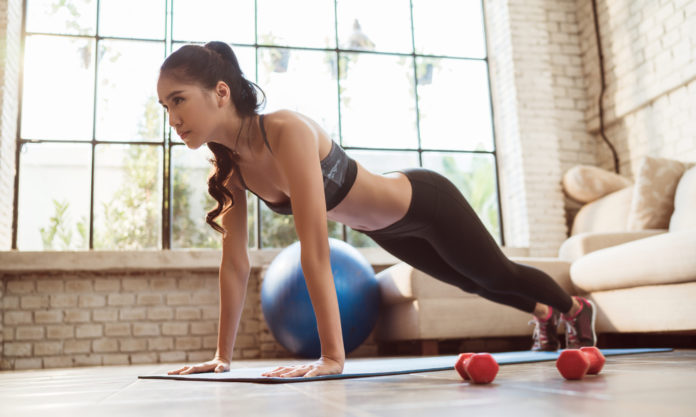The gym is essentially a gathering place to run on the treadmill, cycle on the recumbent bike, and lift heavy weights in the presence of others. This might be motivating for some, while extremely intimidating for others. Not to mention the automatic payments from your bank account each month and 20-minute drive to get there…
That being said, going to the gym is not for everyone. Nor is it necessary to get fit. In fact, you can actually go big while staying home by setting up a home gym. (No waiting for that weight, either…) With the right props and advice, you can turn your living space into an efficient workout area to smash your fitness goals!
Fundamental Tips for Building a Home Gym
1. Designate A Workout Area
Where you plan to workout is important in a number of ways. First off, designating a space just for you is ideal – this means a safe haven where you can focus on your fitness goals free of any sort of distraction.
Common areas for a gym at home include a spare bedroom, office space, corner of a basement, or garage. But it is certainly okay if these areas are unavailable because the most importance is designating a spot you know you will personally use and frequent.
Knowing where the parameters of a workout area likewise gives you a better idea on the equipment you able to utilize and store appropriately.
2. Determine Fitness Goals
Now that your workout area is designated, determine your fitness goals and what you want out of your home gym. Do you want to build muscle? Are you hoping to improve cardio for an upcoming race? Or perhaps you aren’t looking for anything to peculiar, just hoping to follow a healthy lifestyle.
Pro Tip:
While fitness is individualized, general recommendations encourage at least 150 minutes of aerobic exercise weekly, along with at least two to three strength training sessions. The combo of the two supports cardiovascular health while building and toning muscle.
But remember, an at-home gym is predominately for you and should ideally support your fitness ambitions and preferences. Identifying goals correspondingly helps you narrow down the type of equipment you will need.
3. Consider Your Budget
While it may seem like stocking a home gym is costly, it certainly does not have or need to be! Truly know what you want and purchase accordingly. Search for equipment outside of expensive retailers, which including through websites such as Craigslist, at garage sales, or sales throughout the year.
However, it is also important to get quality equipment that will last and is safe to use. Also think long-term: While purchasing a home gym might seem costly compared to a $20 monthly membership, or $240 yearly, a $400 personal gym is forever yours and just over a year and a half later it will pay for itself.
4. Gather Home Gym Essentials
The gear you decide on ordinarily aligns with space and storage of room whilst assisting in your fitness goals. For instance, it is not so plausible to fork out money for a treadmill if storage was an issue and you hate running (we promise there are other forms of cardio)!
While also dependent on room factors and fitness goals, the following home gym essentials bare significant, lasting results when frequently used:
Barbell and Plate Set
If longing to take strength training to a new level, a barbell and plate set is a fundamental element of a home gym to do so. What’s more, there are a number of exercises you can do with a barbell and complementary plates to hit every muscle group.
Legs? Barbell squats and lunges. Chest? Barbell bench presses. Arms? Barbell bicep curls. Back? Bent-over barbell rows. Shoulders? Overhead barbell press. Core? Barbell crunches.
Pro Tip:
Especially if wanting to lift heavy, opt for an Olympic barbell. Unlike standard bars, Olympics withstand hundreds of pounds and the test of time.
Bench and Rack
With a barbell and plate set, should come a bench and rack. A bench offers support, versatility, and the ability to lift heavier weights safely.
Using a rack is also key for lifting heavy weights. And definitely if exercising solo, being able to re-rack a weighted barbell without the assistance of a spotter ensures greater safety. Some racks also increase their fitness functionality by offering attachments for pull-ups and dips.
Pro Tip:
Search for an adjustable bench. This allows for more exercise opportunities and greater range of motions with various angles.
All the Bells
Dumbbells are key for a home gym, particularly if the home area is not conducive to a larger barbell set, bench and rack.
At first, select a few dumbbells that you feel comfortable, yet slightly challenged lifting for bicep curls, shoulder presses, squats, lunges, etc. As time goes on and strength increases, you can add more weights to your repertoire.
Kettlebells also replicate similar exercises you’d do with dumbbells, though add a bit more functional and versatile related to their added element of momentum they bring.
Pro Tip:
If wanting numerous dumbbell weights but don’t have the room for an entire rack of them, an adjustable set perfectly consolidates to maximize gains and minimize space. Kettlebells also come in adjustable options.
Suspension Trainers
Suspension trainers are an excellent addition to any home gym, as they are compact and take up very little room space – all you really need is some sort of anchor point, which may include a door frame, stairwell, or post. Oh, and the one simple piece of equipment offers hundreds of exercises!
Overall, suspension trainers are valuable for targeting all muscle groups, increasing the strength of body joints, and boosting overall muscle stability.
Stability Balls
And no, they stability balls are not just to sit and bounce on… In fact, they are quite versatile and can be used to improve strength, balance, and endurance and these stability ball exercises can take your fitness goals to the next level!
Jump Rope
Resistance training is great and all, but we must not forget the importance of cardiovascular fitness. And rather than sizing in a large treadmill, unless you bare the room and desiring one, a jump rope is a convenient and storage-friendly home gym essential.
Mats
Especially if training with weights, mats are a good idea for all at-home gyms to protect flooring and the integrity of your workout equipment. It can also help minimize sound when using the home gym. (And if sharing walls with others, your neighbors will thank you!)
Mirrors
While mirrors are not mandatory, they can be valuable for ensuring good posture and form during exercises. Just avoid solely focusing on the ‘mirror muscles,’ including biceps, triceps, chest, and abs.
5. Schedule Workouts
A home gym is convenient and all, but also quite meaningless if you never take advantage of it. However, scheduling an at-home gym workout routine can help you stay accountable.
Working out first thing in the morning is recommended regularly, as it limits those post-work excuses and increases focus for the day. But if these morning workout tips for success cannot get you up and going, make it a point to exercise at least three to four days of the week whenever works best for you!









